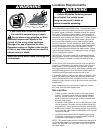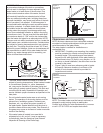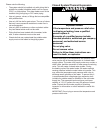
10
Vent Pipe System
This water heater uses a non-direct, single-pipe vent
system to remove exhaust gases created by the burning of
fossil fuels. Air for combustion is taken from the immediate
water heater location or is ducted in from the outside (see
“Combustion Air Supply and Ventilation”).
This water heater must be properly vented for the removal
of exhaust gases to the outside atmosphere. Correct
installation of the vent pipe system is mandatory for the
proper and efficient operation of this water heater and is an
important factor in the life of the unit.
The vent pipe must be installed according to all local and
state codes or, in the absence of local and state codes, the
“National Fuel Gas Code”, ANSI Z223.1(NFPA 54)-latest
edition. The vent pipe installation must not be obstructed so
as to prevent the removal of exhaust gases to the outside
atmosphere.
IMPORTANT: The use of vent dampers is not
recommended by the manufacturer of this water heater.
Although some vent dampers are certified by CSA
International, this certification applies to the vent damper
device only and does not mean they are certified for use on
this water heater.
U.L. recognized fuel gas and carbon monoxide (CO)
detectors are recommended in all applications and should
be installed using the manufacturer’s instructions and local
codes, rules, or regulations.
IMPORTANT: If you lack the necessary skills required
to properly install this venting system, you should not
proceed, but get help from a qualified person.
Drafthood Installation
Align the legs of the drafthood with the slots provided.
Insert the legs and secure the drafthood to the water
heater’s top with the four screws provided as shown in
Figure 9. Do not alter the drafthood in any way. If you are
replacing an existing water heater, be sure to use the new
drafthood supplied with the water heater.
Figure 9
Drafthood Installation
Sheet Metal Screws (four provided)
Drafthood
Jacket top
Install the drafthood with
the four screws provided.
Legs
Slots
Slots
Legs
Vent Pipe Size
It is important that you follow the guidelines in these
instructions for sizing a vent pipe system. If a transition to
a larger vent size is required, the vent transition connection
must be made at the drafthood outlet.
Vent Connectors
1. Type B, Double wall, U.L. Listed Vent Pipe.
2. Single wall Vent Pipe.
Maintain the manufacturer’s specified minimum clearance
from combustible materials when using type B double wall
vent pipe.
Vent connectors made of type B, double wall vent pipe
material may pass through walls or partitions constructed
of combustible material if the minimum listed clearance is
maintained.
Maintain a six inch minimum clearance from all combustible
materials when using single wall vent pipe.
IMPORTANT: Single wall vent pipe cannot be used for
water heaters located in attics and may not pass through
attic spaces, crawl spaces or any confined or inaccessible
location. A single wall metal vent connector cannot pass
through any interior wall.
When installing a vent connector, please note the following:
• Install the vent connector avoiding unnecessary bends,
which create resistance to the flow of vent gases.
• Install without dips or sags with an upward slope of at
least 1/4-inch per foot.
• Joints must be fastened by sheet metal screws or other
approved means. It must be supported to maintain
clearances and prevent separation of joints and
damage.
• The length of the vent connector cannot exceed 75% of
the vertical vent height.
• The vent connector must be accessible for cleaning,
inspection, and replacement.
• Vent connectors cannot pass through any ceiling, floor,
firewall, or fire partition.
IMPORTANT: Existing vent systems must be inspected for
obstructions, corrosion, and proper installation.


















